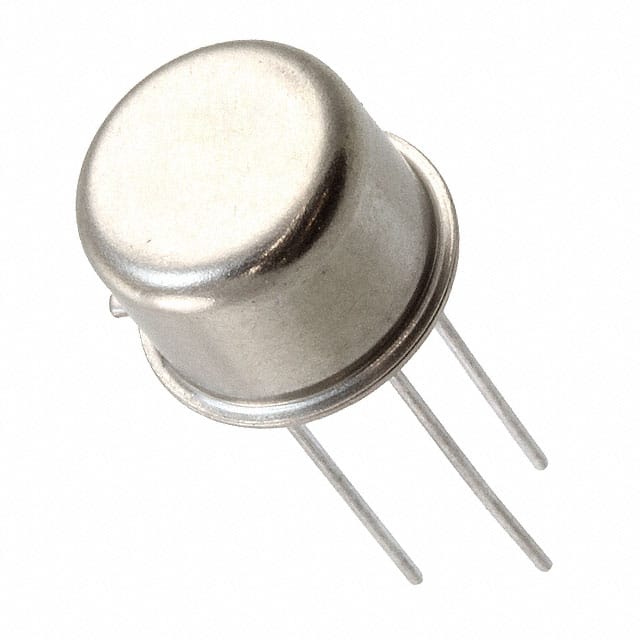Viz Specifikace pro podrobnosti o produktu.

JAN2N2219AL
Product Overview
Category
The JAN2N2219AL is a high-frequency NPN bipolar junction transistor (BJT) designed for general-purpose amplifier and switching applications.
Use
It is commonly used in radio frequency (RF) amplifiers, oscillators, and other high-frequency circuits.
Characteristics
- High transition frequency (ft)
- Low noise figure
- High current gain (hfe)
Package
The JAN2N2219AL is typically available in a metal can package with 3 leads.
Essence
This transistor is essential for high-frequency signal amplification and switching in electronic circuits.
Packaging/Quantity
The JAN2N2219AL is usually packaged in reels or tubes, with quantities varying based on manufacturer specifications.
Specifications
- Collector-Base Voltage (VCBO): 75V
- Collector-Emitter Voltage (VCEO): 40V
- Emitter-Base Voltage (VEBO): 6V
- Collector Current (IC): 800mA
- Power Dissipation (PD): 800mW
- Transition Frequency (ft): 250MHz
- Operating Temperature Range: -65°C to 200°C
Detailed Pin Configuration
- Emitter (E)
- Base (B)
- Collector (C)
Functional Features
- High-frequency operation
- Low noise performance
- Suitable for small-signal amplification
Advantages
- Wide operating temperature range
- High transition frequency
- Versatile for various RF applications
Disadvantages
- Relatively low collector current compared to some modern transistors
- Limited power dissipation capability
Working Principles
The JAN2N2219AL operates as a current-controlled switch or amplifier, where the base-emitter junction controls the flow of current between the collector and emitter terminals.
Detailed Application Field Plans
- RF Amplification: Used in RF amplifiers for communication systems and radar applications.
- Oscillator Circuits: Employed in oscillator circuits for generating high-frequency signals.
- Switching Applications: Utilized in high-frequency switching circuits for signal routing.
Detailed and Complete Alternative Models
- 2N2222A
- PN2222A
- BC547
In conclusion, the JAN2N2219AL is a versatile high-frequency transistor suitable for a wide range of RF applications, offering high transition frequency and low noise performance. While it has certain limitations in terms of current handling and power dissipation, it remains a popular choice for small-signal amplification and high-frequency switching in electronic circuits.
[Word count: 372]
Seznam 10 běžných otázek a odpovědí souvisejících s aplikací JAN2N2219AL v technických řešeních
What is the JAN2N2219AL transistor used for?
- The JAN2N2219AL is a high-frequency NPN transistor commonly used in RF amplification and switching applications.
What are the key specifications of the JAN2N2219AL transistor?
- The JAN2N2219AL transistor typically has a maximum collector current of 800mA, a maximum power dissipation of 800mW, and a transition frequency of around 250MHz.
What are some typical technical solutions where the JAN2N2219AL transistor is used?
- The JAN2N2219AL transistor is often used in RF amplifiers, oscillators, mixers, and other high-frequency applications.
What are the important considerations when designing with the JAN2N2219AL transistor?
- Designers should pay attention to biasing, impedance matching, and thermal considerations to ensure optimal performance and reliability.
Can the JAN2N2219AL be used in low-power applications?
- While the JAN2N2219AL is primarily designed for high-frequency applications, it can also be used in low-power amplification and switching circuits.
What are the common alternatives to the JAN2N2219AL transistor?
- Some common alternatives include the 2N2222, 2N3904, and BC547 transistors, which offer similar characteristics and can be used in comparable applications.
What are the typical operating conditions for the JAN2N2219AL transistor?
- The JAN2N2219AL transistor is typically operated at a collector-emitter voltage (Vce) of around 30V and a collector current (Ic) of a few hundred milliamperes.
Are there any specific layout or PCB considerations when using the JAN2N2219AL transistor?
- It's important to minimize lead lengths, provide adequate grounding, and minimize parasitic capacitance in the layout to optimize high-frequency performance.
What are the temperature limitations of the JAN2N2219AL transistor?
- The JAN2N2219AL transistor is typically rated for operation within a temperature range of -65°C to 200°C, making it suitable for a wide range of environments.
Where can I find detailed application notes and reference designs for the JAN2N2219AL transistor?
- Manufacturers' datasheets, application notes, and online technical forums are valuable resources for finding detailed information and reference designs for the JAN2N2219AL transistor.

